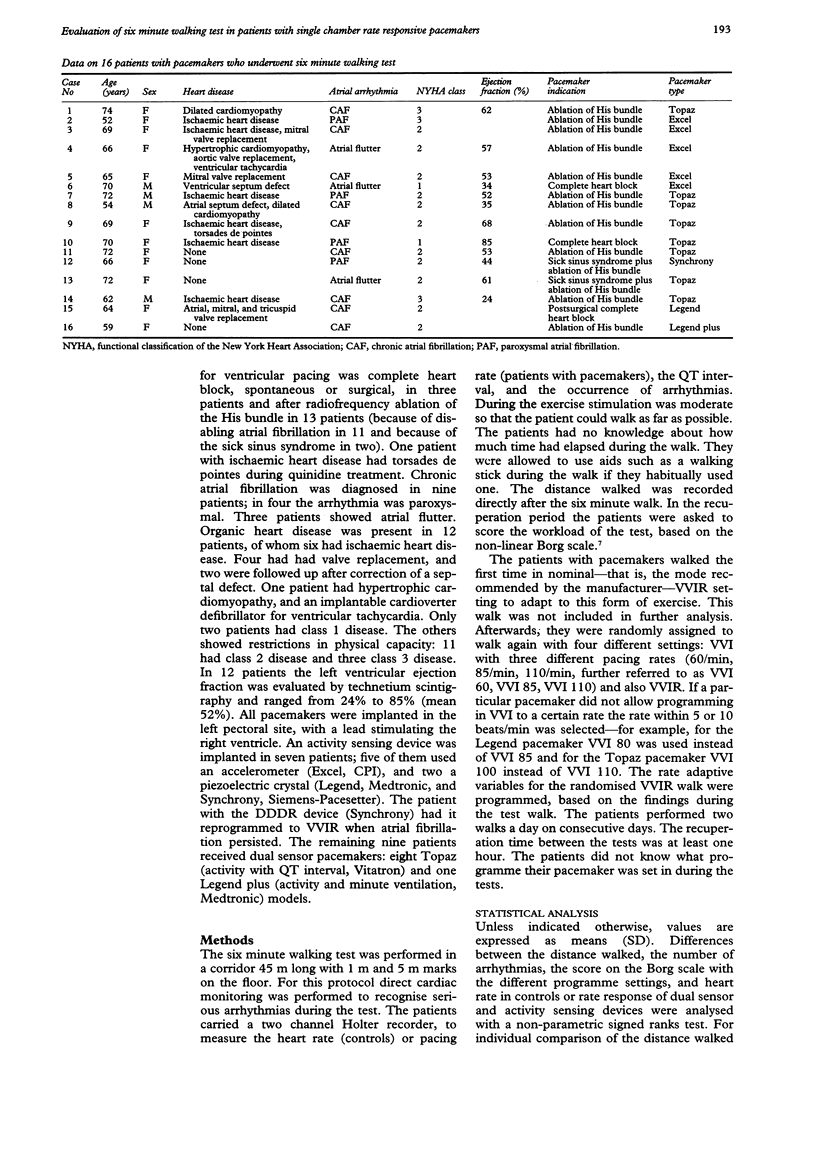Abstract
OBJECTIVE--To validate a simplified exercise protocol (the six minute walk) as a means of evaluating pacing modes and rate responsive pacemakers. DESIGN--Two groups of patients with different pacemaker types (activity and dual sensor) were randomly assigned to four consecutive pacing settings (fixed rate--or VVI at 60, 85, and 110/min, and optimal rate response--or VVIR). A third group of elderly patients without arrhythmias or conduction disturbances formed a control population. SETTING--Ambulatory consultation for patients with a pacemaker in a tertiary referral centre for treatment of arrhythmias. SUBJECTS--16 patients with rate responsive pacemakers for complete heart block and limited functional capacity and 13 controls with normal chronotropic competence. INTERVENTIONS--Submaximal exercise protocol with 6 minutes walking and continuous recording of electrocardiogram. MAIN OUTCOME MEASURES--Achieved distance and scored degree of exertion during walking in the four settings in the patients with a pacemaker; differences in rate behaviour in VVIR mode between the two pacemaker types; comparison of the pacing rate with the heart rate of the control population. RESULTS--The six minute walk was performed better in VVIR than VVI 60. In VVI 85 the distance was also significantly longer than in VVI 60. The rise in pacing rate of activity pacemakers was steeper than that of the dual sensor pacemakers and differed from the heart rate in the controls at 90 seconds. CONCLUSIONS--The studied test protocol was able to show differences in exercise capacity between pacing modes. Different rate responses between the evaluated sensor types could be established. The six minute walking test gives enough information to program and reprogram single chamber rate responsive pacemakers.
Full text
PDF




Selected References
These references are in PubMed. This may not be the complete list of references from this article.
- Borg G. A. Psychophysical bases of perceived exertion. Med Sci Sports Exerc. 1982;14(5):377–381. [PubMed] [Google Scholar]
- Butland R. J., Pang J., Gross E. R., Woodcock A. A., Geddes D. M. Two-, six-, and 12-minute walking tests in respiratory disease. Br Med J (Clin Res Ed) 1982 May 29;284(6329):1607–1608. doi: 10.1136/bmj.284.6329.1607. [DOI] [PMC free article] [PubMed] [Google Scholar]
- Furman S. Rate-modulated pacing. Circulation. 1990 Oct;82(4):1081–1094. doi: 10.1161/01.cir.82.4.1081. [DOI] [PubMed] [Google Scholar]
- Hayes D. L., Von Feldt L., Higano S. T. Standardized informal exercise testing for programming rate adaptive pacemakers. Pacing Clin Electrophysiol. 1991 Nov;14(11 Pt 2):1772–1776. doi: 10.1111/j.1540-8159.1991.tb02764.x. [DOI] [PubMed] [Google Scholar]
- Humen D. P., Kostuk W. J., Klein G. J. Activity-sensing, rate-responsive pacing: improvement in myocardial performance with exercise. Pacing Clin Electrophysiol. 1985 Jan;8(1):52–59. doi: 10.1111/j.1540-8159.1985.tb05723.x. [DOI] [PubMed] [Google Scholar]
- Jordaens L., Backers J., Moerman E., Clement D. L. Catecholamine levels and pacing behavior of QT-driven pacemakers during exercise. Pacing Clin Electrophysiol. 1990 May;13(5):603–607. doi: 10.1111/j.1540-8159.1990.tb02076.x. [DOI] [PubMed] [Google Scholar]
- Langenfeld H., Schneider B., Grimm W., Beer M., Knoche M., Riegger G., Kochsiek K. The six-minute walk--an adequate exercise test for pacemaker patients? Pacing Clin Electrophysiol. 1990 Dec;13(12 Pt 2):1761–1765. doi: 10.1111/j.1540-8159.1990.tb06886.x. [DOI] [PubMed] [Google Scholar]
- Lau C. P. The range of sensors and algorithms used in rate adaptive cardiac pacing. Pacing Clin Electrophysiol. 1992 Aug;15(8):1177–1211. doi: 10.1111/j.1540-8159.1992.tb03121.x. [DOI] [PubMed] [Google Scholar]
- Lipkin D. P., Perrins J., Poole-Wilson P. A. Respiratory gas exchange in the assessment of patients with impaired ventricular function. Br Heart J. 1985 Sep;54(3):321–328. doi: 10.1136/hrt.54.3.321. [DOI] [PMC free article] [PubMed] [Google Scholar]
- Lipkin D. P., Scriven A. J., Crake T., Poole-Wilson P. A. Six minute walking test for assessing exercise capacity in chronic heart failure. Br Med J (Clin Res Ed) 1986 Mar 8;292(6521):653–655. doi: 10.1136/bmj.292.6521.653. [DOI] [PMC free article] [PubMed] [Google Scholar]
- McGavin C. R., Gupta S. P., McHardy G. J. Twelve-minute walking test for assessing disability in chronic bronchitis. Br Med J. 1976 Apr 3;1(6013):822–823. doi: 10.1136/bmj.1.6013.822. [DOI] [PMC free article] [PubMed] [Google Scholar]
- Parameshwar J., Dambrink J. H., Sparrow J., Wright C., Park A., Tweed J., Poole-Wilson P. A. A new exercise test for the assessment of heart failure: use of a self powered treadmill. Br Heart J. 1989 May;61(5):421–425. doi: 10.1136/hrt.61.5.421. [DOI] [PMC free article] [PubMed] [Google Scholar]
- Perrins E. J., Morley C. A., Chan S. L., Sutton R. Randomised controlled trial of physiological and ventricular pacing. Br Heart J. 1983 Aug;50(2):112–117. doi: 10.1136/hrt.50.2.112. [DOI] [PMC free article] [PubMed] [Google Scholar]
- Recommendations for pacemaker prescription for symptomatic bradycardia. Report of a working party of the British Pacing and Electrophysiology Group. Br Heart J. 1991 Aug;66(2):185–191. [PMC free article] [PubMed] [Google Scholar]
- Rossi P., Plicchi G., Canducci G., Rognoni G., Aina F. Respiration as a reliable physiological sensor for controlling cardiac pacing rate. Br Heart J. 1984 Jan;51(1):7–14. doi: 10.1136/hrt.51.1.7. [DOI] [PMC free article] [PubMed] [Google Scholar]
- Sowton E. Exercise testing in the indication and evaluation of pacemaker treatment. Eur Heart J. 1987 Aug;8 (Suppl 500):155–158. doi: 10.1093/eurheartj/8.suppl_d.155. [DOI] [PubMed] [Google Scholar]
- Sulke N., Dritsas A., Chambers J., Sowton E. Is accurate rate response programming necessary? Pacing Clin Electrophysiol. 1990 Aug;13(8):1031–1044. doi: 10.1111/j.1540-8159.1990.tb02150.x. [DOI] [PubMed] [Google Scholar]


